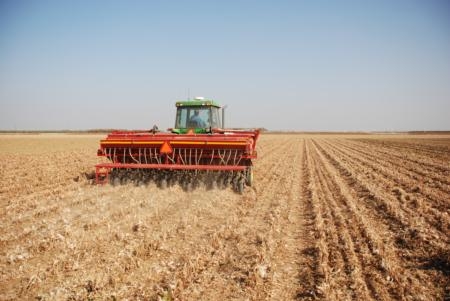
Posts Tagged: vegetable
New Row Crops Publication

This publication can help growers and land owners comply with conditional waivers for irrigated lands. The publication focuses on best water management methods that will maintain a higher level of water quality and reduce pollutant impacts. It includes a questionnaire that growers can use to evaluate their practices and a checklist for assessing and implementing a plan for managing soil, irrigation, fertilizer and pests for a variety sites.
Link to these publications on our website at:
"Row Crops Best Management Practices to Protect Water Quality"
“Prácticas de Cultivo de Hortalizas para Proteger la Calidad del Agua”
The ANR Catalog should have a hard copy available for sale in the near future.
UCCE Ventura Celebrates 100 Years of UC Cooperative Extension Service

The University of California, Agriculture and Natural Resources (UC ANR) division is celebrating 100 years of service and science to the state of California. In May 2014 UC ANR will mark the 100th anniversary of the Smith-Lever Act, legislation that created Cooperative Extension, a nationwide system of community-based education, established as part of each state's land grant university.
The Ventura County UC Cooperative Extension is our local component of this structure where we serve the community through youth development programs, agricultural outreach and research, home gardening programs, natural resource education and projects, environmental horticultural and landscape expertise. We also work in conjunction with the Hansen Agriculture UC Research and Extension Center (REC) in Santa Paula where agricultural research projects and educational outreach programs are conducted in a dedicated agricultural setting.
Join us at our 100th anniversary celebratory meeting in Oxnard and learn more about the extension and research activities.
Date: January 29, 2014
Time: 8:00 am to Noon
Location:
Courtyard by Marriott
600 E. Esplande Dr.
Oxnard
RSVP by January 20, 2014 to 805-525-3839, ext. 214 or sbmiller@ucanr.edu or respond online.
Click here for more information and the agenda.
Apium virus Y on celery in coastal California
California farms produce 93% of the celery grown in the United States. The crop thrives in coastal California’s moderate climate. Celery is an important crop in Ventura County with 40% of the state’s acreage farmed here. Valued at over $182 million, it was the second most profitable crop for Ventura County agricultural producers in 2010, which are the most recent statistics available.
Most celery in the field is planted as transplants. Transplants are typically grown under high humidity and high plant density conditions and are subject to seedborne pathogens. The most significant being Septoria apiicola (the causal agent of Septoria late blight) and Pseudomonas syringae pv. apii (the causal agent of bacterial blight). These diseases can be carried from the transplants into the field. As the plants mature, these diseases can cause plants to become unmarketable at a great loss to the growers.
UCCE’s Oleg Daugovish and collaborators researched these pathogens and how to best reduce disease and loss in the field. Over four years, the researchers documented that: seed, seedlings, weeds located in or near fields that harbor the virus can cause the disease in celery. This disease is likely transmitted by aphids, vectoring the virus.
The studies provided practices growers can use to manage this disease. Findings indicated that growers can control the pathogens by managing poison hemlock weed populations, controlling aphids, and planting celery cultivars that are not susceptible to the pathogens.
The interpretive and technical summaries of the research report can be viewed on this page of the USDA’s Agricultural Research Service. The full text can be accessed through the American Phytopathological Society, or at the UCCE office in Ventura County.
Cover Cropping for Vegetable Production
The University of California Agriculture and Natural Resources Division (UC ANR) has recently released a new priced publication, Cover Cropping for Vegetable Production: A Grower’s Handbook.
Written by a collaborative of UC researchers, including Ventura County Farm Advisor Oleg Daugovish this handbook brings together the expertise of many.
Topics include:
- Introduction of cover crops for vegetables and their uses
- Botany and species selection
- Agricultural soil ecology
- Water management and impacts on water quality
- Soil nitrogen fertility management
- Weeds
- Soilborne pathogens
- Plant and soil nematodes
- Arthropods
- Cover crop management
- Economics
We currently have a few copies for sale in the office, or you may purchase online. If purchasing online, please use promo code PRVEN56 to receive 10% off your order.

Companion Planting
Companion planting, or intercropping, can create improved biodiversity in agroecosystems. The concepts of companion planting can be used in home gardens or in commercial agriculture.
Beneficial plant associations can provide many positive interactions in the field or garden. They include:
- Trap cropping
- Symbiotic nitrogen fixation
- Biochemical pest suppression
- Physical spatial interactions
- Nurse cropping
- Beneficial habitats
- Security through diversity
To learn more about companion planting, mixed intercropping, or strip intercropping, please see Companion Planting: Basic Concepts & Resources. Digital versions of this publication are free from ATTRA (Appropriate Technology Transfer for Rural Areas). ATTRA is the national sustainable agriculture information center funded by the USDA’s Rural Business – Cooperative Service.

Mustards planted next to strawberries to encourage natural enemies in Ventura County. Photo by Jack Kelly Clark.

